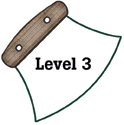
Alaska Science
Key Element D3
A student who meets the content standard should recommend solutions to everyday problems by applying scientific knowledge and skills.
 |
Alaska Science A student who meets the content standard should recommend solutions to everyday problems by applying scientific knowledge and skills. |
|
Performance Standard Level 3, Ages 11–14
|
|
|
|
Sample Assessment Ideas
|
|
|
Expanded Sample Assessment Idea
|
|
Procedure Students will:
Reflection and Revision
|
Levels of Performance |
||
|
Stage 4 |
Student work is complete and contains evidence of elaboration, extension, higher-order thinking skills, and relevant knowledge. Student actively participates in meeting with local populace and helps identify community area most affected by flooding or erosion; and actively participates in student group to investigate the problem area, collect data and make recommendations based on the data. Student identifies a second site affected by same problem and determines if this site could benefit from the same solution. | ||
|
Stage 3
|
Student work is complete but may contain some evidence of inaccuracies, omissions or misconceptions. Student participates in meeting with local populace as they identify community area most affected by flooding or erosion. Student participates in student group to study the problem area and make recommendations based on their observations. Student may identify a second site affected by the same or similar problem and determine if this site could benefit from the same solution. | ||
|
Stage 2
|
Student work may be incomplete, incorrect, or inaccurate. Student attends meeting with local populace and works with student group to visit the problem area. Recommendations may be based solely on personal experience or non-science factors (e.g., economics, aesthetics, etc.) Student may identify a second site that is unrelated to the first site. | ||
|
Stage 1
|
Student work is incomplete, inaccurate, and lacking in relevant details. Student does not attend meeting with local populace or attends the meeting but does not follow along with the discussion to identify a problem area. Student is a reluctant group participant and does not make recommendations for the problem area. | ||
Standards Cross-References
|
||
|
National Science Education Standards Identify appropriate problems for technological design. Students should develop their abilities by identifying a specified need, considering its various aspects, and talking to potential users or beneficiaries. They should appreciate that for some needs, the cultural backgrounds and beliefs of different groups can affect the criteria for a suitable product. (Page 165) Design a solution or product. Students should make and compare different proposals in the light of the criteria they have selected. They must consider constraints such as cost, time, trade-offs, and materials needed and communicate ideas with drawings and simple models. (Page 165) |
Benchmarks Design usually requires taking constraints into account. Some constraints, such as gravity or the properties of the materials to be used are unavoidable. Other constraints, including economic, political, social, ethical, and aesthetic ones, limit choices. (Page 51) |
|
Table of Contents | Return to Alaska Native Knowledge Network